Important Shortcut Keys
| Toggle Fullscreen: | F11 (most browsers) |
| Undo Move: | Ctrl+Z |
| Deal Again: | F2 |
| Close Dialogue Box: | Esc |
Solitaire
Welcome to Solitaire Online, also known as Klondike Solitaire or Classic Solitaire! This is the most popular version of solitaire online, and so needs no further introduction. Enjoy!
Overview
Solitaire is a patience game, and also goes by names such as Klondike Solitaire, Classic Solitaire, Traditional Solitaire or simply Solitaire. It is the most popular solitaire game all over the world. It is a card game played by one player. The objective, as with most other patience games, is to sort the cards by sequence and suit by placing them in the foundation fields located in the top-right corner of the screen. It is not always possible to win the game. In fact, the game is only winnable in around half of the cases!
The game board consists of seven columns in a characteristic triangle-like shape. The first column has just one card, the second has two, the third has three, and so on. All cards are laid face down except for the last card in the column, which is placed facing up. In the top-left corner, there is a stock where more cards can be drawn from. Depending on the variant of the game, the player can draw one or three cards, which are then placed on the waste pile. If three cards are drawn at a time, then the cards on the waste pile are fanned to the right, so that the player can always see the most recent three cards.
Solitaire Rules
Foundation Fields
The game has four foundation fields that the player should place cards in. The first card to be placed into a foundation field (the Foundation Card) is an Ace. Then, the cards are to be placed sequentially on top of the Ace matching its suit. Since the game uses one full deck – 52 cards – there is enough space to place all of the cards: 4 packs of 13 cards per suit sums up to 52 cards.
Unlike in other solitaire games (for example, Freecell), it is possible to get cards from the foundation fields and place them back in one of the columns. This is called "worrying back", and it is useful when you find an important card in the stock but have no place to put it on the board.
Columns
Initially, most cards are facing down. To reveal a card, you need to remove all of the up-facing cards lying on top of it.
Cards can be moved between columns, from a column to a foundation field, and to a column from the waste pile or foundation field. A card (or a pile of cards) can be placed on another card in a column only if the destination card is one rank higher and the opposite color to the card that is being moved. In other words, columns can only be built sequentially by alternating colors.
Only a King can be placed in an empty column.
You can right-click on a card to send it to a foundation field. You can also right-click on the area below cards to send all suitable cards to foundation fields.
The Stock and the Waste Pile
There is a stock of cards located in the top-left corner of the game board. Once no more moves can be made using the cards in the columns, then more cards can be drawn from the stock.
The stock functions in two modes: you can draw one card at a time or three cards at a time. The cards drawn from the stock are placed on the waste pile. If you draw one card at a time, then only one card at the top of the waste pile is visible. If you draw three cards at a time, three fanned cards are visible (as long as there are three or more on the pile). You can pick a card from the top of the waste pile and then place it in a column or a foundation field, in accordance with the respective rules of placing cards.
Once you have gone through all cards in the stock, you may or may not be able to take the waste pile and use it again as a stock. Whether or not you are permitted to do this depends on how many cards you draw from the stock, as well as on the scoring method that you are using.
Drawing three cards at a time results in a slightly harder game, because when you draw one card at a time, you will go through all of the cards eventually. In contrast, when you draw three cards at a time, you can sometimes get stuck, and certain cards in the stock will be unavailable - even if you were to go through it over and over again.
Scoring
There are four distinct ways of scoring in classic Solitaire. The first way is to not use scoring at all. This is the most flexible method, and allows you to reuse the waste pile as a stock for as many times as you wish, regardless of whether you draw one card at a time or three.
The second way of scoring is known as Vegas Scoring. The player starts the game being $52 in debt, and can make money by placing cards in the foundation fields, which is worth $5 each time. It is not hard to calculate that solving the game wins the player $208. This is hard, however, because the number of times that the player can go through the stock and waste pile is severely limited. When one card is drawn at a time, it is only possible to go through the cards in the stock once. When three cards are drawn at a time, it is possible to go through the cards in the stock three times.
Next, there is Standard Scoring. Initially, the player’s score is zero. Standard Scoring awards 5 points for putting a card in a column. It also awards 10 points for placing a card in a foundation field. Note that in order to get the maximum number of points out of a card from the stock, you should first place it in a column and then move it to a foundation field, which will award you 15 points altogether. With this method of scoring, the number of times you can go through the stock is unlimited. However, whenever you revert the waste pile back into the stock, you will lose 100 points.
The final method of scoring is Timed Scoring. This closely resembles Standard Scoring except that it also involves the passage of time. In particular, a small number of points is periodically deducted. Also, at the end of the game, a bonus is awarded. The bonus amount depends on how quickly you solve the game.
Strategy
There is not much to consider in terms of strategy when it comes to traditional Solitaire. This is mostly a game of luck. The game is not always winnable, even if you are clairvoyant. That is because in some deals, the cards are simply arranged on the board in such a way that it is impossible to untangle them, no matter what you do. To be specific, the game is winnable only around 40% of the time.
However, there are some basic rules that should help you increase your number of wins. For example, it is not always the best idea to put suitable cards in the foundation fields as soon as you discover them. It may be wise to hold onto them for a while and keep them on the board, in case another important card shows up that can be placed on them.
How to play Solitaire – Solving Example
In this example, we are going to show how to start the game when three cards are dealt from the stock at a time. The purpose of this example is to illustrate the rules, but by no means is it an example of optimal play.
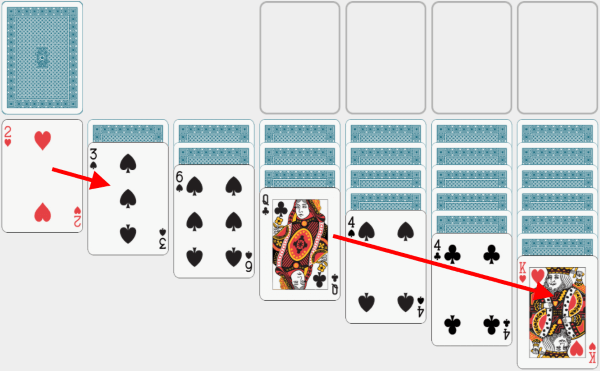 From the start, we see that there are two moves we can make. We can place the 2 of Hearts on the 3 of Spades, and the Queen of Clubs on the King of Hearts. We cannot place the 3 of Spades on either of the 4s, because they are all black. |
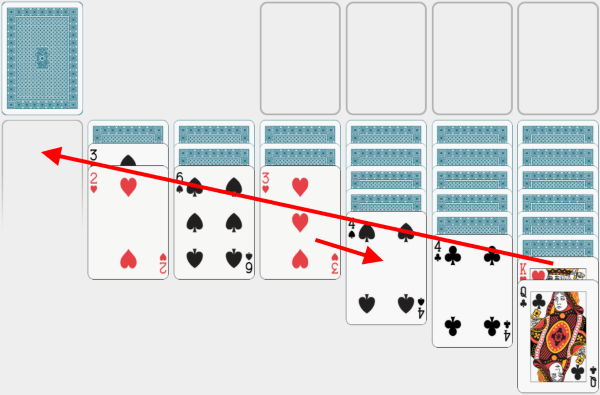 It is good that the 3 of Hearts has been revealed. We can place it on the 4 of Spades which is next to it. Also, we can move the King and the Queen from the last column onto the first column. |
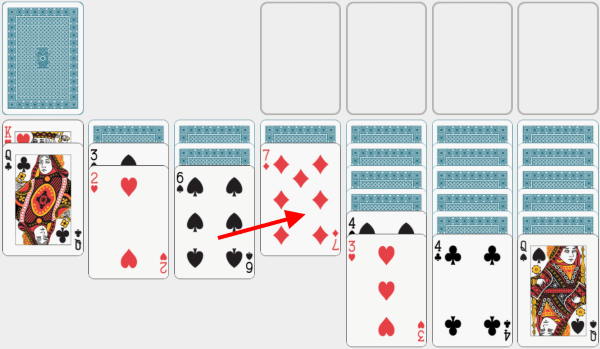 Now, we can place the 6 of Spades onto the 7 of Diamonds. |
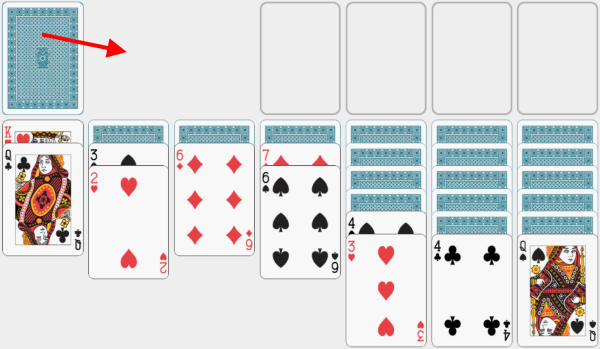 Since there are no more moves that we can make, we should now draw cards from the stock. |
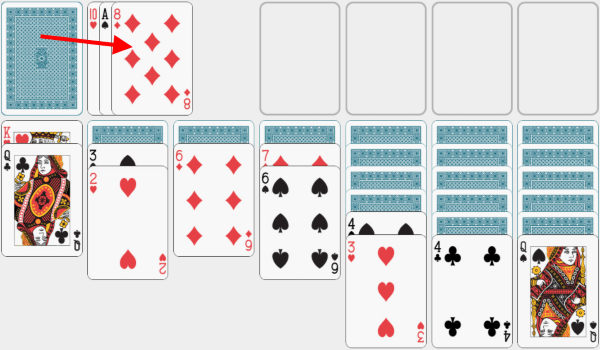 The 8 of Diamonds does not seem to be useful in any way, so we draw from the stock once again. |
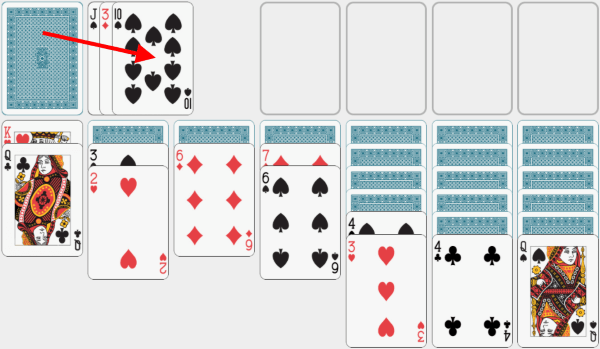 The 10 of Spades does not help us either. Hence, we draw from the stock again. |
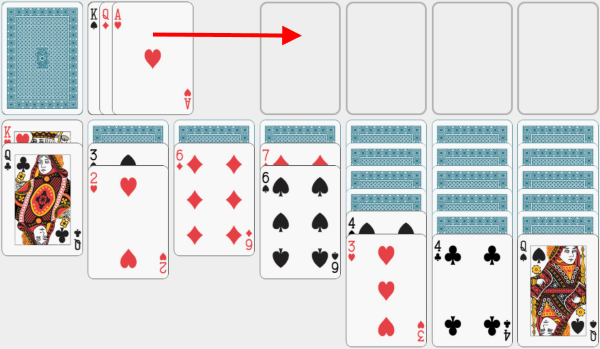 Finally, a useful card has shown up! And this is actually an Ace. We can now place it in the first available foundation field. |
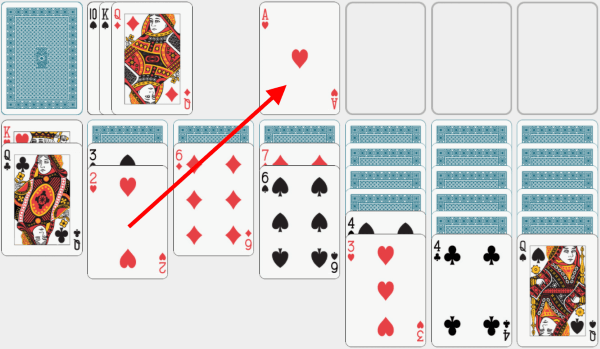 Now, we can place the 2 of Hearts on the Ace in the foundation field. |
 Notice that we could place the 3 of Hearts on the 2 of Hearts in the foundation field. We are not going to do that though, because the 3 of Hearts can still be useful to us on the board. If we discover the 2 of Spades or the 2 of Clubs before we find the corresponding Aces, we can use the 3 of Hearts to temporarily store these cards. Therefore, we will keep the 3 of Hearts in place for now. Instead of moving it, we will draw three more cards from the stock. |
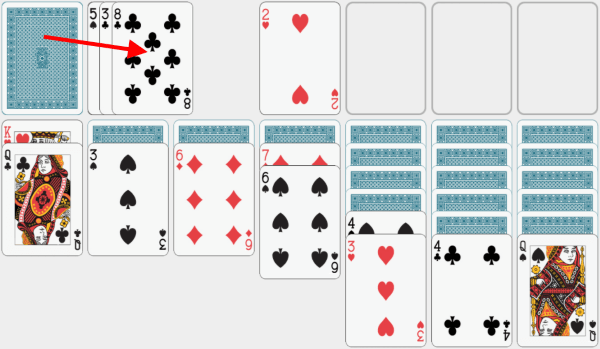 Again, there are no useful moves available, and so we draw again from the stock. |
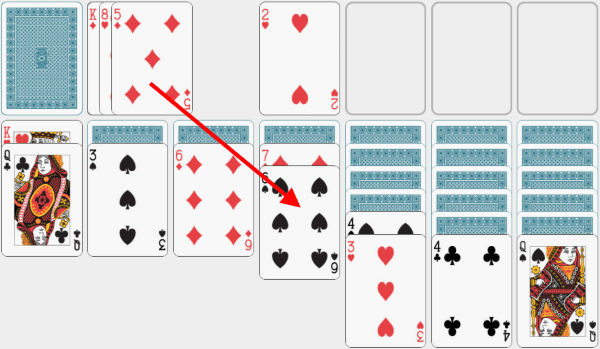 Let’s place the 5 of Diamonds on the 6 of Spades. |
 Finally, we can again move some cards around on the board. Let’s take the 4 of Clubs from the sixth column and place it on the 5 of Diamonds in the fourth column. |
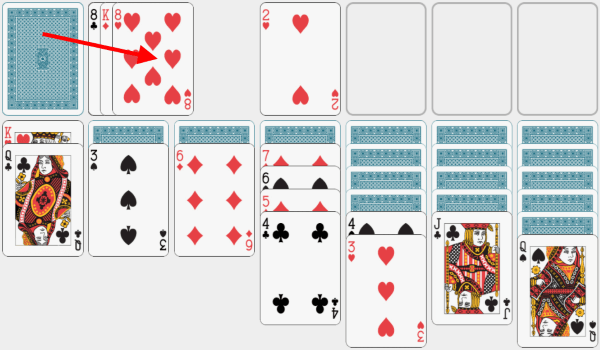 No additional moves available. But don’t worry – this is quite common. Let’s draw from the stock. |
 Let’s draw one more time. |
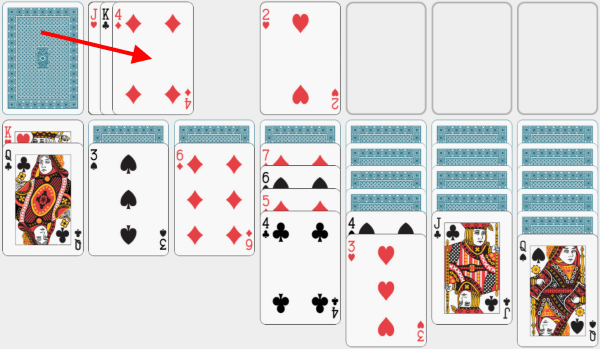 And again. |
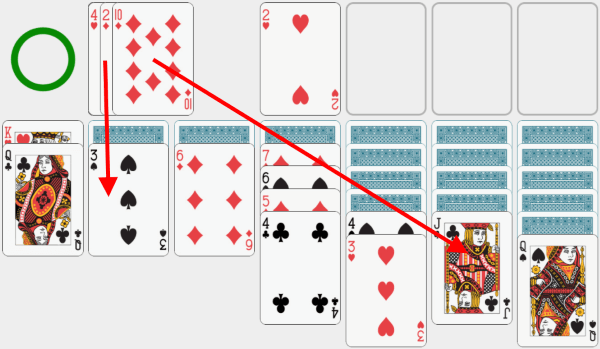 We have now reached the end of the stock. Fortunately, though, there are a couple of useful moves that we can make. We can place the 10 of Diamonds on the Jack of Clubs, which reveals the 2 of Diamonds. This, in turn, can be placed on the 3 of Spades. |
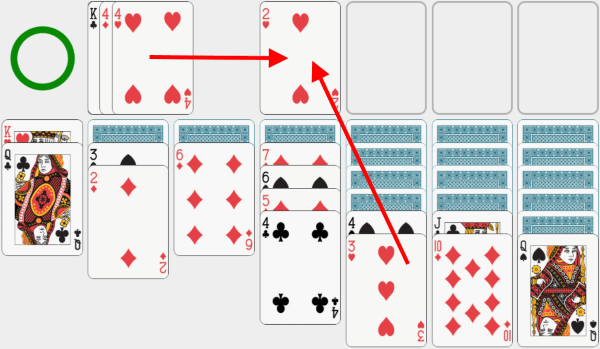 Since there is a 4 of Hearts in the waste pile, we probably should not wait any longer for an opportunity to use the 3 of Hearts. Instead, we should use it now. Let’s place both the 3 and the 4 of Hearts in the foundation field. |
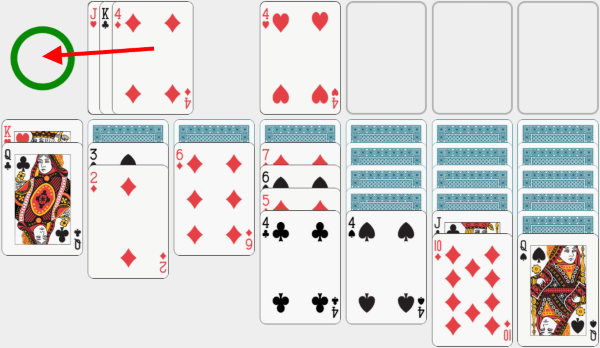 Let’s put all the cards from the waste pile back in the stock pile. |
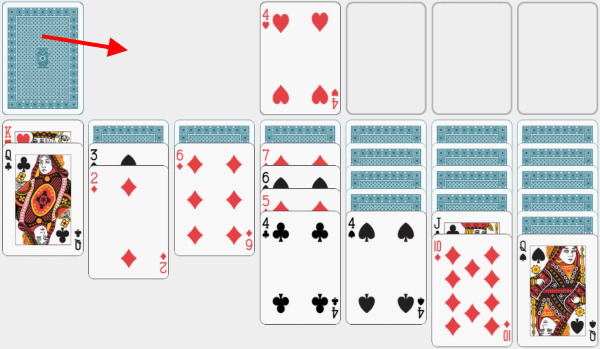 Draw three cards from the stock. |
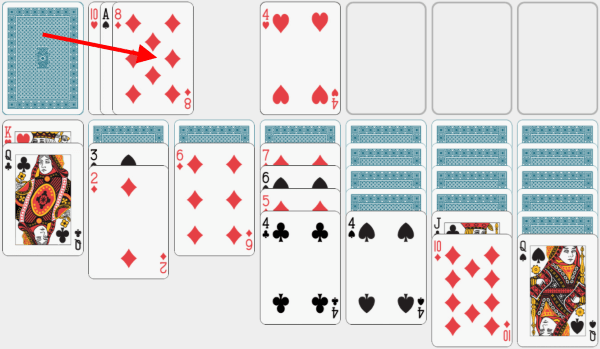 Again, draw three cards from the stock. |
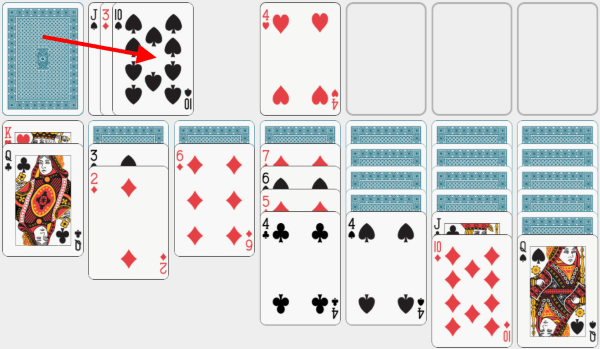 And again. |
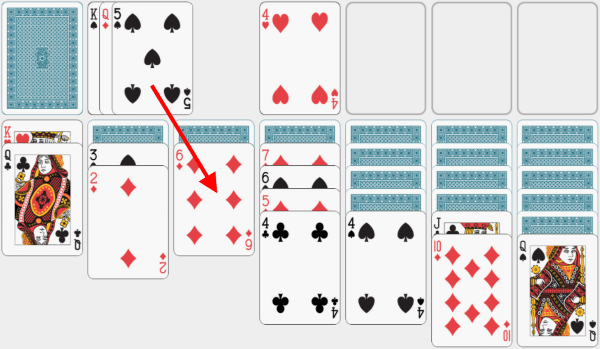 Now, we can place the 5 of Spades on the 6 of Diamonds. |
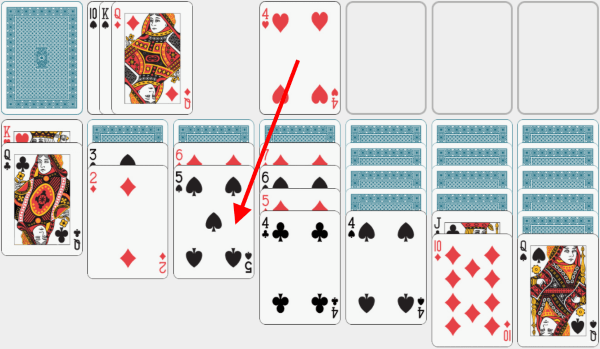 Let’s move the 4 of Hearts back. Pick it up from the foundation and place it on the 5 of Spades. Soon enough, you will see why. |
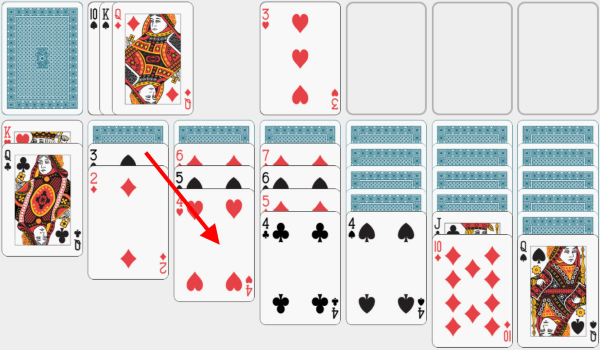 Now, we can place the 3 of Spades and the 2 of Diamonds on the 4 of Hearts. |
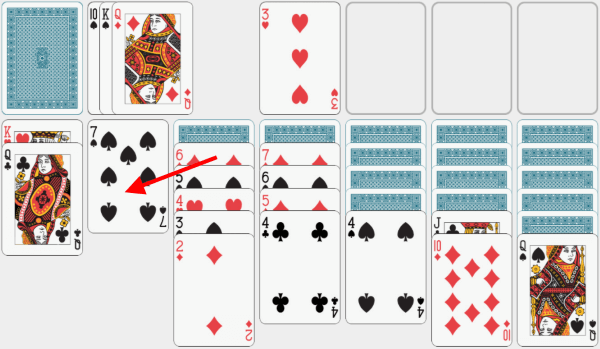 Then, we can move the entire five-card pile from the third column onto the 7 of Spades seen in column two. This concludes our little tutorial! You should now know all the basic moves, along with a couple of handy starting strategies. Good luck! |
History
Patience, or solitaire in general, is a type of card game which can be played by one player. The objective is most often to sort the cards by suit and sequence, and put them in the foundation fields which are often located (but not exclusively) at the top of the game board.
It is important to note that the game was not mentioned in large game compendiums in the Seventeenth Century, but was first mentioned in a German game anthology in the late Eighteenth Century. Thus, the origins of patience as a genre are traced back to this time in Germany, or alternatively to Denmark or Norway, as suggested by the name that was used to describe it: kabale. The first printed collection of patience games was created in 1870, and ignited the interest in Solitaire, with many more books on the topic following afterward.
Klondike Solitaire (alternatively known as Classic Solitaire or simply Solitaire) became popular in the Nineteenth Century, and was probably named after the town located close to the border between Alaska and Canada, where a gold rush occurred in the last years of the Nineteenth Century. From there, it spread all over the world, and it is now widely considered to be the most popular patience game.
The computer version of Klondike Solitaire was first created for the Microsoft Windows 3.0 operating system in the 1990s. It is considered to be the first casual video game. The game was included to help users become more familiar with the graphic interface and the drag-and-drop technique. The game quickly became popular, and according to recent estimates, Solitaire has 35 million active monthly players.
Unfortunately, due to its popularity, Solitaire has contributed to a drop in office productivity, and is often disabled or removed from the Windows operating system by system administrators. This led to the creation of many online solitaire games which are becoming ever more increasingly popular - and not just among office workers. This version of online Solitaire has been inspired by the games available on the Windows operating system, especially Windows 7, and was created to look as similar to it as possible.
Copyright © 2021-2025 simiade.com. All rights reserved. | Terms and Conditions | Privacy Policy